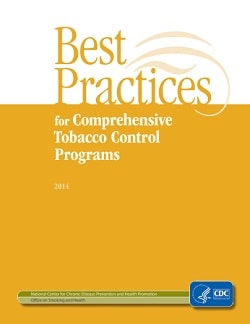At a glance
Best Practices for Comprehensive Tobacco Control Programs—2014 is an evidence-based guide to help states build and maintain effective tobacco control programs to prevent and reduce tobacco use. This document updates Best Practices for Comprehensive Tobacco Control Programs—2007. This updated edition describes an integrated approach to program development and provides recommended funding levels for effective state programs.
Best Practices for Tobacco Control Programs

Letter From the Director, Executive Summary, and Introduction
Section A. Components of a Comprehensive Tobacco Control Program
- State and Community Interventions
- Mass-Reach Health Communication Interventions
- Cessation Interventions
- Surveillance and Evaluation
- Infrastructure, Administration, and Management
Section B. Recommended Funding Levels for All 50 States and the District of Columbia
Section C. Recommended Funding Levels, by State
- Alabama
- Alaska
- Arizona
- Arkansas
- California
- Colorado
- Connecticut
- Delaware
- District of Columbia
- Florida
- Georgia
- Hawaii
- Idaho
- Illinois
- Indiana
- Iowa
- Kansas
- Kentucky
- Louisiana
- Maine
- Maryland
- Massachusetts
- Michigan
- Minnesota
- Mississippi
- Missouri
- Montana
- Nebraska
- Nevada
- New Hampshire
- New Jersey
- New Mexico
- New York
- North Carolina
- North Dakota
- Ohio
- Oklahoma
- Oregon
- Pennsylvania
- Rhode Island
- South Carolina
- South Dakota
- Tennessee
- Texas
- Utah
- Vermont
- Virginia
- Washington
- West Virginia
- Wisconsin
- Wyoming
Appendices
A. Funding Recommendation Formulations
B. Program and Policy Recommendations for Comprehensive Tobacco Control Programs
C. National Prevention Strategy Recommendations
D. Guidelines for Comprehensive Local Tobacco Control Programs
E. Data Sources
Fact sheets
- Overall Fact Sheet
- State Funding Fact Sheet
- Achieving Equity by Identifying and Eliminating Tobacco-Related Disparities Fact Sheet
- State and Community Interventions Fact Sheet
- Mass-Reach Health Communication Interventions Fact Sheet
- Cessation Interventions Fact Sheet
- Surveillance and Evaluation Fact Sheet
- Infrastructure, Administration, and Management Fact Sheet
Best Practices User Guide: Cessation
This user guide provides insight to the concept of health systems change and how it is used to create efficient methods for increasing and promoting automatic referrals to cessation services. There is information on how to promote health systems change, improve insurance coverage for cessation treatment, and support state quitlines.
Best Practices User Guide: Health Communications
This user guide offers program staff and partners information on how to effectively develop and implement paid media, earned media, social media, and other types of communication methods and tools to support tobacco control efforts.
Best Practices User Guide: Health Equity
This user guide offers information on how to identify gaps in health equity. It also shows how to work toward achieving health equity in tobacco control when planning, implementing, and enforcing policies, programs, and interventions.
Best Practices User Guide: Partnerships
This user guide expands and updates the recommendations in the 2009 Coalitions user guide. It helps tobacco control programs explore, develop, and maintain strategic partnerships and build coalitions to achieve commercial tobacco control goals.
Best Practices User Guide: Program Infrastructure
This user guide helps tobacco control programs address challenges with programmatic infrastructure to maintain a relevant and effective tobacco control program.
Best Practices User Guide: Putting Evidence into Practice
This user guide can help programs share information about what works to reduce commercial tobacco use. It also helps programs put new or improved tobacco control interventions into practice.
Putting Evidence Into Practice User Guide—Download
Putting Evidence Into Practice User Guide—Order Printed Guide
Best Practices User Guide: Youth Engagement
This user guide emphasizes that the youth perspective is critical to tobacco prevention and control. Most people start smoking cigarettes before age 18. Tobacco control programs need to understand how to engage youth as a part of a comprehensive tobacco control program.
Best Practices—Tobacco Where You Live: Native Communities
Read about the Tobacco Where You Live series and how it fits in with the Best Practices User Guides. Understand why a culturally focused approach is important to reduce commercial tobacco use disparities among American Indian and Alaska Native people.
Best Practices—Tobacco Where You Live: Mapping Techniques
Read about the Tobacco Where You Live series and how it fits in with the Best Practices User Guides. This Mapping Techniques supplement helps users create effective maps in six easy steps. Users can also learn how state programs use maps to support tobacco prevention and control goals. The supplement also helps users identify the best resources and tools to get started.
